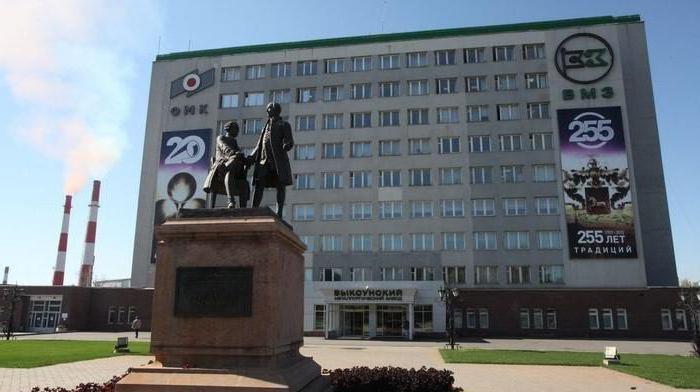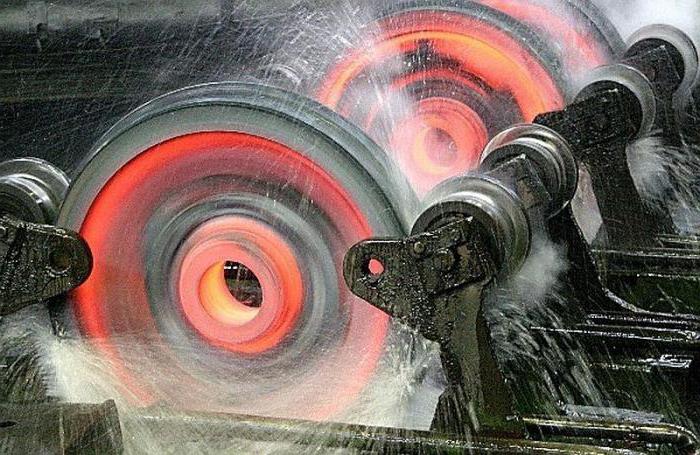VMZ OJSC (Vyksa Metallurgical Plant) is a leader in the production of wheels for railway transport and pipe rolling. This is one of the oldest Russian industrial enterprises. Included in JSC OMK-Holding.
History of creation
The Vyksa Metallurgical Plant arose in the iron ore district around the ancient city of Vyksa, Nizhny Novgorod province, through the merger of several small industrial enterprises of Batashevs. In 1768, the Lower Plant was founded at the lower dam of the Spare Pond, consisting of 10 wooden buildings: two of them were molotovye, one had eight horns, and the other four. In the rest of the buildings there were flatting machines, furnaces, a nailing center with four hammers, and a sawmill. On the bank of the Lower Pond there are two wooden hammer cases and a two-story stone building with six ticks and twelve boobies, a forge, a large locksmith, warehouses, and a flour mill.

At the Nizhne-Vyksa plant, they produced: iron (strip, high-grade, sheet, tire, hoop), krits, nails, wire, tools. In the late 1830s, the first pudding furnaces were installed for the production of iron in pieces in a new puddling method. In 1842, there were already 10 such furnaces; each capacity was up to 10 pounds (96-100 kg).
By the middle of the XIX century, the Vyksa Metallurgical Plant became bankrupt. He was handed over to the German Lessing. In 1892, the first open-hearth furnace for steel production was installed in the reconstruction of the Lessing period, in 1894 the open-hearth furnace shop appeared, which after 20 years already had 4 furnaces with a capacity of 12, 16, 18 and 25 tons. A new sheet rolling mill was also built. In 1907, pipe production was organized. With the outbreak of the First World War, for political reasons, the workshops were handed over to the merchant Staheev, who in 1916-1917, together with the Ministry of Railways built two new buildings for the production of road vehicles.
Soviet period
After the arrival of the Bolsheviks, production earned even more intensively. In 1923, a fork rolling mill was opened, in 1925 - a small-section one. 10/01/1928 on the basis of the Nizhne-Vyksa, Doschat and Verkhne-Vyksa enterprises the united Vyksa Metallurgical Plant (VMZ) was founded.
Until August 1929, V.I. was the director of VMZ. Ustinov, then - V.N. Mazurin. In the years of the first five-year plans, the plant developed and was reconstructed. An open-hearth workshop No. 2 was built, a small-grade workshop was reconstructed, a huge amount of work was done on the electrification and mechanization of production processes.
In 1930-1933, open-hearth shop No. 2 was erected nearby and in 1935, pipe No. 2. The people called these four buildings the New Plant, in the documents it was considered an expanded refinery. At the beginning of the 20th century, energy workshops were located on the territory: steam-powered and electric.
Specialization and modernization
Since the Soviet period, Vyksa Metallurgical Plant JSC has maintained leadership in the production of wheels for railway transport. Also traditional is the production of pipes. For the first time, powder metallurgy was mastered at the enterprise , and the pipe-welding workshop No. 5 , built in 1985, was considered the most advanced. In 1991, the technologically even more advanced pipe-welding shop (TPP) No. 4 was put into operation. Due to the ongoing cooperation with Russian Railways and joining the United Metallurgical Company, VSW not only survived in the 90s, but also retained enviable production volumes.
In the 2000s, modernization continued. Were introduced:
- Area for applying anti-corrosion coatings (2000).
- The furnace ladle vacuum degasser (2004).
- Installation of local heat treatment of welds (2004).
- Line of single-seam-straight-line-seam large-diameter pipes for gas and oil pipelines, up to 1420 mm (2005).
- Volumetric pipe heat treatment workshop (2007).
- New casing production complex (2010).
- The metallurgical complex MKS-5000 (2011) and other projects.
TPP-4
Pipe-electric welding shop No. 4 is the pride of the enterprise. Today, the pipes of the Vyksa Metallurgical Plant are in demand in the oil and gas industry, but their implementation was difficult. In February 1978, SMU-1 of the Metallurgstroy Trust began to fill the foundation of TESC-4, where it was planned to produce gas pipeline multilayer pipes obtained from sheet metal.
In 1982, the first phase of the workshop began production of pipes with a maximum diameter of 1420 mm, but due to the novelty of the process technology, multilayer pipes had a number of drawbacks. In 1987, production was temporarily discontinued, and it was decided to reconstruct the workshop using foreign technologies.
In 1992, the Vyksa Metallurgical Plant produced the first single-seam and straight-line-seam pipe, and then production of 508-1020 mm products was launched, and it began to flow power. Today, products are manufactured by two independent lines using alternative technologies JCO-1420 and UOE-1020. VSW in 1998 received a license from the State Technical Supervision Service of the Russian Federation for the production of trunk pipelines.
Open-hearth shop №2
OJSC Vyksa Steel Works is famous for foundry. Open-hearth shop No. 2 was built from 1930 to 1933 with two furnaces of 90 tons each to provide metal for the sheet-rolling workshop. After the war, 2 reconstructions were carried out with an increase in the capacity of furnaces, first up to 185 tons, and then up to 250 tons each. In the 70s they built a furnace number 5, but in the 2000th it was eliminated.
The first head of the open-hearth shop No. 2 was S. Nesterenko - Metallurgical engineer, graduate of the Ekaterinoslav (Dnepropetrovsk) Mining Institute. The first heat in furnace No. 5 was released on September 28, 1933. Since 1941, armored steel on 90-ton furnaces has been produced in the workshop. There was no analogue to this not only in our country, but also abroad. The workshop always took care of introducing new equipment and technology. In the 1950s, they switched to working with basic chromomagnesite arches instead of dynamos, introduced automation of the thermal regimes of furnaces, built waste heat boilers and a laboratory and household building.

In the 60s, they mastered a new method of express analysis of metal, and vapor-vapor cooling of individual parts on furnaces was established. In 1974, the development of the production of wheeled steel began. The first heat was released on June 18 of the same year. In 1985-1990, overhauls of all three furnaces were carried out with a change in their design. In 2006, the open-hearth workshop became part of the wheel rolling complex.
Wheel Rolling Shop
In 1969, the Vyksa Steel Plant began construction of Europe’s largest railway wheel workshop. The KPC was declared the object of the regional shock Komsomol construction. The first stage, the finishing line, was launched on October 1, 1973. Exactly one year later, the construction of the second stage was completed, which made it possible to achieve design capacities for press-rolling production (650,000 railway wheels per year) and thermomechanical processing (850,000 wheels).

Products are made of steel of own production. KPC equipment is highly automated and mechanized. The workshop has mastered the manufacturing process for manufacturing solid-rolled wheels with a rim of increased hardness, various disk configurations and machining of all elements. The main consumers are enterprises of the Ministry of Railways of Russia. In addition, the wheels are supplied to the CIS countries, South Korea, Serbia, USA, Slovakia, Bulgaria, India, Indonesia, Vietnam. In 2006, the KPC combined with the open-hearth workshop in a wheel-rolling complex.
Museum
On September 13, 1958, the executive committee of the Vyksa City Council of People's Deputies decided to establish a public historical and revolutionary museum in Vyksa. From 1958 to 1987, expositions were housed in the Palace of Culture. Lepse.
On July 2, 1985, the master’s house of the Batashevs breeders was transferred to the balance of the Vyksa plant. In January 1992, he acquired the status of the Museum of History of OAO VMZ. Created by the efforts of enthusiastic employees, local historians, residents of Vyksa, who shared exhibits, documents on the history of the plant and the city, the Museum of the History of VMZ to this day stands in the service of society. He acquires, stores, researches, promotes and exhibits evidence of the history of the Vyksa Territory.
Vyksa Steel Works: contacts
- Address: 607060, Nizhny Novgorod region, Vyksa city, Batashev Brothers Street, 45.
- Managing Director: Barykov Alexander Mikhailovich.
- Contact number: (800) 25-01-150.
- Fax: (83177) 37-605.
- Reception: (495) 23-17-771, additional - 3903.